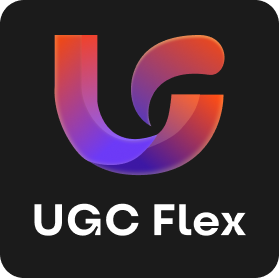User-generated content has emerged as the dominant force in modern marketing because it leverages deep-seated psychological principles that make consumers feel understood, validated, and connected. The psychology of viral UGC content involves a complex interplay of emotional triggers, cognitive biases, and social dynamics that brands can strategically harness to build authentic connections with their audiences.
Key Takeaways
- UGC is perceived as 3 times more authentic than professional brand content, explaining why UGC ads work so effectively
- Content that triggers high-arousal emotions like awe, happiness, or even controlled anxiety has greater viral potential
- Platform-specific strategies are crucial as TikTok UGC outperforms traditional brand content by 22%
- Effective UGC follows proven psychological frameworks that leverage cognitive biases and emotional triggers
- The future of UGC marketing lies in AI-enhanced authenticity and personalized emotional engagement
The Power of Authenticity: Why Consumers Trust UGC
The remarkable effectiveness of UGC’s authenticity advantage is backed by impressive statistics. Research shows that user-generated content is perceived as three times more authentic than professional brand-generated content, creating a foundation of trust that traditional marketing simply cannot match. This fundamental psychological connection helps explain why UGC ads work so effectively.
This authenticity translates directly into purchasing decisions. According to Wiser Notify’s research, an overwhelming 92% of consumers trust reviews and user posts more than advertisements when shopping, and 79% say UGC directly influences their buying decisions. The cognitive psychology in advertising suggests that perceived authenticity bypasses our natural skepticism toward commercial messaging.
The trust factor extends to specific product categories as well. For apparel brands, 66% of shoppers base their clothing purchase decisions on reviews and comments from other users. This demonstrates how social proof in user-generated content creates a psychological shortcut for decision-making by letting consumers rely on the experiences of others.
Brands that understand this dynamic can build marketing strategies that leverage user-generated content as a trust-building mechanism rather than simply viewing it as free promotional material. The authenticity in UGC ads creates a psychological foundation that makes all other marketing efforts more credible.
Emotional Triggers and Psychological Drivers Behind Viral UGC
The secret to creating viral social media content lies in understanding the emotional triggers in UGC ads that prompt sharing and engagement. Research published in the Journal of Marketing Research found that content evoking high-arousal emotions—whether positive (like awe and excitement) or negative (like controlled anxiety or surprise)—has significantly higher viral potential.
While both positive and negative emotions can drive engagement, positive content generally outperforms negative messaging in terms of sharing and conversion rates. This emotional engagement in UGC creates a psychological connection that brand-generated content often struggles to achieve. When users feel emotionally moved, they’re more likely to share content, extending its reach organically.
The psychology behind why people create UGC in the first place reveals important motivations. Humans have a fundamental desire to belong and understand social trends, which drives participation in content creation. This explains the FOMO in viral content—people create and share UGC partly to demonstrate their social awareness and connection.
Users also strategically align their content with both their online and offline identities, using UGC as a form of identity expression and reinforcement. This psychological alignment creates content that feels genuine rather than manufactured, contributing to the authenticity that makes UGC so persuasive.
Social proof serves as another powerful motivator in UGC creation. When consumers see others participating in a trend or sharing experiences with a brand, they’re more likely to join these engaged communities. Casper’s successful unboxing campaign demonstrates how leveraging social proof psychology can create a self-perpetuating cycle of user content generation, with each new piece of content motivating more users to participate.
UGC Performance Metrics: Engagement and Conversion Success
The effectiveness of user-generated content extends beyond psychological appeal to measurable performance advantages. According to data from Billo’s UGC research, content featuring real users earns 28% higher engagement rates than traditional brand content, demonstrating how authentic voices capture and hold attention more effectively.
The conversion impact is equally impressive. Brands incorporating UGC into their marketing mix see a 29% increase in web conversions compared to campaigns relying solely on professional content. This translates directly to bottom-line results, explaining why brands increasingly incorporate user content into their core marketing strategies.
Platform-specific metrics highlight the power of UGC across different channels:
- Instagram posts featuring user content generate 70% more likes and comments
- UGC-based advertisements receive 4x higher click-through rates
- Brands using UGC enjoy a 50% reduction in cost-per-click for their ads
These statistics reveal why a comprehensive user-generated content marketing strategy has become essential for brands looking to maximize their marketing ROI. The combination of higher engagement and lower costs creates a compelling business case beyond just the psychological benefits.
Platform-Specific UGC Strategies: Where Content Thrives
Different social platforms foster unique UGC environments, requiring tailored approaches for maximum impact. TikTok has emerged as a particularly powerful UGC channel, with users 58% more likely to trust user content than on other platforms. Additionally, TikTok UGC outperforms brand-created content by 22% and delivers 32% better results than Facebook branded ads, making it a prime platform for monetization.
Instagram continues to be a powerhouse for engagement, with posts featuring user content receiving 70% higher interaction rates. This visual platform particularly excels for certain industries, with 80% of destination marketing organizations preferring UGC content on Instagram over other channels. Creators can leverage these platform-specific strategies to maximize their content’s effectiveness.
YouTube offers unparalleled longevity for UGC, with user-created videos and shorts receiving almost 10 times the views of branded content. The platform generates approximately 17% of the most engaging UGC content according to marketers, making it ideal for comprehensive product demonstrations and experiences that benefit from longer viewing times.
Pinterest may be the 15th most popular social platform for promotions, but it offers a unique advantage: one-third of Pinterest shoppers have incomes over $100K, making it valuable for premium brands leveraging UGC. Creators looking to price their services effectively should consider these platform-specific advantages.
Creating Compelling UGC Scripts: Formulas for Success
The most successful UGC content follows proven psychological frameworks that leverage cognitive biases in UGC to maximize impact. According to inBeat Agency’s research, effective UGC scripts typically follow the Direct Response Formula: Hook → Problem → Solution → Value Proposition → Social Proof → Call to Action.
This structure works because it aligns with how our brains process information and make decisions. The hook captures attention by triggering emotional or curiosity-based responses, while the problem-solution framework activates our psychological desire for resolution and improvement. This approach is particularly effective for creators developing monetization niches.
Effective UGC also balances brevity with engagement. In today’s crowded digital landscape, scripts must be concise yet instantly compelling. This requires focusing on the practical utility of UGC—showing real-world applications and benefits rather than abstract claims.
Storytelling elements significantly enhance UGC effectiveness by creating emotional connections. Good UGC scripts craft relatable scenarios that:
- Feel authentic rather than overly polished
- Include personal details that humanize the experience
- Incorporate humor in viral content when appropriate
- Demonstrate real-world problem-solving
- Encourage active viewer participation
For creators looking to pitch services to brands, understanding this psychological framework is crucial. The most successful UGC strikes the perfect balance between authenticity and strategic messaging, making the content feel genuine while still serving brand objectives.
The Future of UGC: AI Integration and Evolving Trends
The intersection of AI and UGC trends is creating exciting new possibilities for content creators and brands alike. AI tools are now helping to analyze emotional triggers in successful UGC, enabling more precise targeting of content that aligns with specific psychological responses. This scientific approach to content creation is making the psychology of viral UGC content more accessible to creators at all levels.
Despite technological advances, authenticity remains the cornerstone of effective UGC. As research from TINT shows, the psychological impact of genuine user experiences cannot be replicated by AI alone. The future lies in AI-enhanced authenticity rather than AI-generated content, with technology amplifying real human experiences rather than replacing them.
Personalization is becoming increasingly sophisticated in the UGC space. Content that adapts to individual user preferences and behaviors shows significantly higher engagement rates. This trend toward hyper-personalized UGC leverages the psychological principle that people respond most positively to content that feels specifically relevant to their needs and interests.
For creators looking to stay ahead of the curve, emerging content trends suggest that the most successful UGC will continue to evolve toward more interactive formats. Content that invites participation rather than passive consumption creates stronger psychological engagement and has greater viral potential. Building a personal brand around authenticity positions creators for long-term success in this evolving landscape.
Leveraging UGC Psychology for Career Growth
Understanding the psychological principles behind viral UGC isn’t just academically interesting—it’s a marketable professional skill. Creators who can consistently produce content that triggers the right emotional responses and leverages cognitive biases are increasingly valuable to brands seeking authentic connections with consumers.
For those looking to build a sustainable career in content creation, UGC Flex offers a comprehensive development program designed for today’s creator economy. Their cohort includes free courses on content creation, contract negotiations, technical and video editing skills—all essential capabilities for translating psychological insights into effective content.
UGC Flex helps creators transform their content into recurring revenue streams, building careers rather than just one-off projects. The program features gamified learning experiences, leaderboards, and access to curated communities of top creators and industry experts who understand the science behind viral content creation.
If you’re ready to leverage the psychology of viral UGC content to build a thriving creator career, consider joining UGC Flex’s next cohort. Their approach combines psychological insights with practical skills, preparing you to create content that doesn’t just perform well—it connects on a fundamental human level. Sign up today to transform your understanding of UGC psychology into a sustainable creator career.

